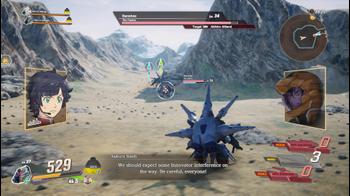
SD Gundam Battle Alliance Review
I have been looking forward to SD Gundam Battle Alliance ever since its announcement back in February. Sure, I’m a bit of a sucker for Gundam games, but this one stood out from a legacy standpoint. When Bandai Namco revealed that Artdink was developing it, I knew I had to get my hands on the game.
Artdink had a resurgence in global markets earlier this year with the release of Triangle Strategy. In recent years prior to that, the studio had mostly been working on releasing entries in the A-Train series, a simulation game, in Japan. Artdink was most active during the peak of the PSP era, and their name is one that resonates in very niche western communities that imported (or “obtained”) Gundam games on the PSP, since those games never received official English localizations. From the handful that I played back then, the two I enjoyed the most were Gundam Battle Chronicle and Gundam Battle Universe.
To put it into perspective, the last time Artdink developed a Gundam game before SD Gundam Battle Alliance was Gundam Seed Battle Destiny on the Vita in 2012. Yep, it’s been a whole decade already, and that’s why I was so curious to see how SD Gundam Battle Alliance would turn out.
I ultimately came away from SD Gundam Battle Alliance a little mixed - though not necessarily in a bad or negative way. I’ll mention upfront that this game supports multiplayer co-op for up to 3 players, and because I… well, played this before launch, I had to go through all of it entirely by my lonesome.
SD Gundam Battle Alliance feels like a game best experienced playing with friends, rather than going it solo. Its early stages and super deformed (SD) aesthetic may give off the impression that the game will be a walk in the park, but that increasingly became not the case as I progressed further and further in. Most of this boils down to the game’s heavy emphasis on teamwork to overcome challenges.
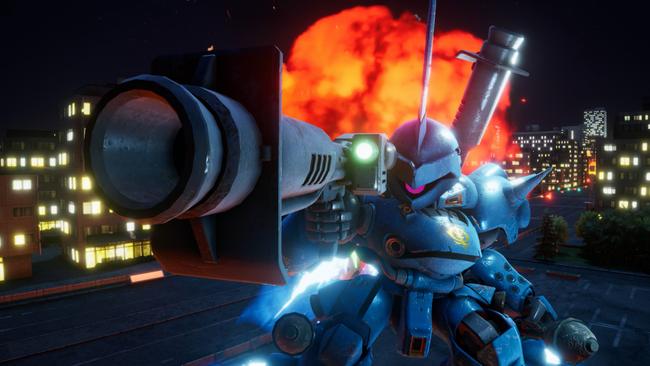
This crossover action RPG has the usual array of light and heavy attack strings for each of its playable Mobile Suits. Each of them have a melee and ranged attack option, along with several universal mechanics like being able to launch enemies into the air, perform an air combo, and smash them back to the ground. Many of the suits exhibit unique properties in their combo strings to keep them from feeling the same as one another. Some units may have animations that move them behind foes for extra damage or attack cancels that keep enemies longer in a juggle state. All attack strings consume boost, so players can’t combo forever and are limited by a boost meter.
Defense options come in the form of guarding and dashing. Guarding blocks damage by a decent margin and perfect guards nullify damage entirely. Perfect guards of incoming melee attacks will execute a counterattack that will send enemies flying in a juggle state - even against normal-sized bosses. If opponents knock a player down, they can perform a recovery maneuver to quickly rise up again.
What largely separates Mobile Suits from each other is their two unique subweapons. These often open up combo route options for them, since players can freely utilize their ranged weapon and subweapons in the middle of attack strings as long as they’re off cooldown.
Since enemies are defenseless when entered into a juggle state, optimizing combo routes is beneficial for squeezing out damage. Instead of executing the standard air launcher, jump, melee combo string into a finisher, the Nu Gundam can opt to stay on the ground after the launcher, keep its helpless target in the air with its fin funnels instead, extend it even further with a few beam rifle shots, then chase after it with some melee hits into a hyper bazooka finisher.
Driving the combo number higher has another benefit besides more damage. Units have a special attack they can execute when its gauge fills up. When expended, they gradually fill up again on a timer, though achieving 10-, 30-, and 50-hit combos will shave away a few seconds on it.
Another meter to manage, the skill meter, dictates two other game systems: Chain Breakers and Role Actions.
Chain Breakers are an amusing mechanic in SD Gundam Battle Alliance because it is very much inspired by fighting games in the same vein as Arc System Works’ Guilty Gear and BlazBlue series. When people are getting juggled by opponents, they can spend that meter to execute a Chain Breaker to push their assailants back - which is very similar to how bursts operate in several fighting games.
A Chain Breaker can also be used when a person isn’t being attacked. Instead of serving as an escape option, this different type of Chain Breaker refills the boost and guard gauges immediately if it hits an enemy. This can be pulled off in the middle of attack strings as a combo extender as well.
Role Actions - also activated from the skill meter - are a key component in SD Gundam Battle Alliance in distinguishing the “jobs” of the 3-person team. Every playable Mobile Suit in the game is categorized as an Infighter, All-Rounder, or Sharpshooter; these are set in stone for each unit and cannot be changed or swapped. The names of the roles themselves clue people in on what sort of playstyle a unit specializes in from the get-go and the Role Actions are very different between each of the three categories.
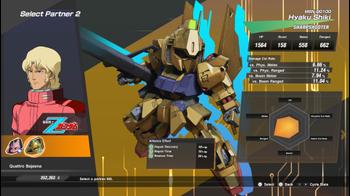
Infighters receive temporary hitstun immunity from incoming attacks, so they can focus solely on their onslaught without fear of being interrupted; this does not mean they are immune from the damage those attacks will do, so they still have to be wary of their HP. All-rounders can extend their combos even more, since their Role Action increases the cancel timing for all their attacks for a limited time. Meanwhile, the Role Action on Sharpshooters refills all their ranged and subweapon cooldown meters instantaneously which bolsters their offensive options from a distance.
As people level up their overall account level, they will gradually unlock more Pilot Skills and some of those add additional effects on Role Actions too.
There is a surprising amount of depth in the moment-to-moment gameplay in SD Gundam Battle Alliance, especially if three people are working together, I imagine. If someone is going into it as a single-player experience only, this game can feel overwhelming when it comes to boss encounters, especially ones that have players face off against massive Mobile Armor bosses.
Due to the restricted amount of healing options available, solo players will begrudgingly have to rely on their AI teammates to work with them. Infighters, All-Rounders, and Sharpshooters carry a different amount of repair kits into missions. They can heal a unit’s HP when their health is low, but repair kits can also be expended for an emergency self-resurrect without needing anyone else’s help to get back into the fray. Repair kits are quite limited with Infighters equipped with three, All-Rounders with four, and Sharpshooters carrying the maximum of five. Repair kits are only replenished when starting a stage, so they can feel very limited when playing alone.
As usual for these sorts of games, the AI teammates start off serviceable at the beginning when the stages are simple and easygoing. Once the difficulty ramps up, it increasingly becomes a challenge to work with them. Their movement and attack patterns are slow, so their damage output is far less than what it would be if you partnered with other human players. When I was downed, the AI would do their best to resurrect me though they would most likely be hit out of it unless someone else took aggro, so vicious loops of failed attempts to revive me were common; the AI has no regard for self-preservation in these cases.
Since SD Gundam Battle Alliance smartly surfaces who has a boss’s attention at any given time, a common scenario would occur where the AI partner taking aggro would also be the one trying to revive me, instead of the other AI teammate that is off aggro attempting to save me instead. It is a pretty frustrating situation, because the default normal difficulty feels like it was tuned for multiplayer as the damage values you have to deal with are nothing to scoff at. Players can only withstand a few hits before they find themselves laying flat on the ground with a depleted life bar.
The cherry on top? There are no checkpoints at all during missions. Once everyone is down, players will be sent back to the mission select screen and have to re-do it all again. Only the money and experience earned are brought back. This poses a tricky situation, especially for solo play, because some later stages can last for more than 20 minutes, so it is a heavy time loss if players fail at the final stretch of those lengthier ones.
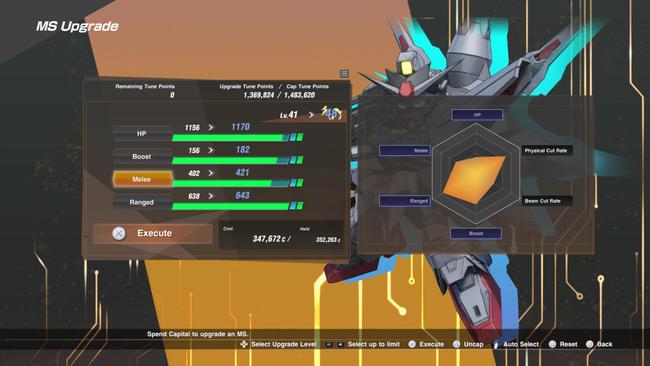
To its credit, the game is a lot more enjoyable and intense than I was initially expecting. I am eagerly excited to play this through again with my friends, because it feels rewarding triumphing over SD Gundam Battle Alliance’s numerous tough encounters. Bosses have crazy attack patterns that push players to respect what they’re doing at any given moment. The Big Zam fight was one of the early wake-up calls for me that this game would not be a pushover.
Enhancing Mobile Suits is done by spending in-game money to upgrade a unit’s HP, boost, melee, and ranged stats. Each unit has a level cap that can be further uncapped with materials dropped in stages. As players level up each of the four parameters, the unit’s level itself will increment. There’s a maximum “tuning cost” to a Mobile Suit that prevents every stat to be absolutely maxed. Players can decrease a stat to take back tuning cost points, but their money won’t be refunded either. Tuning costs are largely not a concern because the biggest setback will be how monetarily expensive upgrading stats can get in each uncap.
As I progressed further into SD Gundam Battle Alliance, I noticed what will probably become a common dilemma for players. As players make their way through the game, they will earn blueprints to unlock new Mobile Suits. Early on, the blueprint requirements won’t be as demanding to give people a decent selection off the bat. Later Mobile Suit unlocks will ask for a lot more types of blueprints, which will involve grinding earlier stages that drop those specific items. Take into consideration that unit upgrade costs dramatically increase in each uncap.
Players will find themselves in a situation where they can’t quite hop between different units to progress and instead will have to find one or two Mobile Suits as their main ones to continue on, unless they are willing to grind out money to invest in other Mobile Suits to try out. At the very least, there is a free tutorial that serves as a training mode to check out the tools and movesets of other Mobile Suits before you spend those resources. Regardless, people will be pushed to only play a select few if they want to keep on pushing through new content, unless they invest the time to grind in both unlocking and upgrading other Mobile Suits.
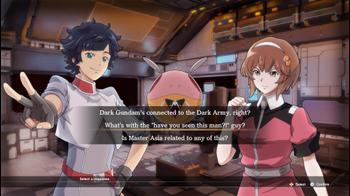
In a roster of over 65 playable characters, it can feel restrictive and bogged down in that aspect. My playthrough with minimal grinding and not taking excessive time to farm blueprints to unlock every single character clocked in at a little over 22 hours. Keep in mind that most of SD Gundam Battle Alliance’s content is structured around replayability, so my completion time will probably not be indicative of the standard time it will take for people who want to unlock everything this game has to offer. There are other post-game challenges unlocked when every single stage is completed on normal difficulty, with a higher difficulty that provides higher-rarity parts and further level uncaps for Mobile Suits along with some new challenges.
SD Gundam Battle Alliance’s story is nothing too special, truth be told, but it is surprisingly charming for Gundam fans that have watched several of the shows. The player’s main character is a silent grunt from the One Year War that gets warped with another character named Juno Astarte to a mysterious place that observes the various Gundam timelines as they happen in a simulation. There they meet an AI construct that they nickname Sakura Slash.
Its plot is reminiscent of how SD Gundam G Generation World handled its Generation Break mechanic. When you first start stages for the first time, these will often be Break Missions that have allied and enemy units from different Gundam series appear in them; the relevant heroes and villains will often be missing for some reason. A very early example of this is how Ramba Ral’s Gouf is suddenly replaced by Mikazuki’s Gundam Barbatos from Iron Blooded Orphans as it is about to assault the White Base from the original first Gundam show.
As players complete more Break Missions to find where Ramba Ral went off to, they’ll eventually find which timeline he is in. Upon locating and completing Break Missions, True Missions begin to appear that restore the canon of what actually occurred during those timelines. Juno and the protagonist are told that the only way to return to their One Year War timeline is to help Sakura Slash investigate the causes for why all these Breaks appear, so it is merely a convenient excuse for the game to have fun crossovers with many, many different Gundam series.

For Gundam fans, there is a lot of fanservice for them. Juno comes from an uninformed point of view that has no idea what is going on in any of these Gundam series, so Sakura serves as the fun exposition Gundam fangirl character to sum up what is happening with everything unfolding before Juno. Sakura has a lot of fun bringing up 4th-wall-breaking iconic lines, mimicking characters, and so on. All Juno can really do is nod at her insanity and the English localization team has a ton of fun breathing life and flavor into the game’s script.
Characters from multiple Gundam series have a chance to interact with each other as well; there were parts that reminded me of how the first Dynasty Warriors: Gundam had fun with its strangely charming crossover moments in SD Gundam Battle Alliance. As iconic protagonists, antagonists, and a few side characters clash from multiple Gundam timelines, a few interesting conversations emerge of how some characters would have reacted to each other if they really did meet in canon.
One amusing late game stage is taking Amuro around a facility and various alternate universe protagonists showing up. His bewilderment towards the design of the Turn A Gundam and G-Self as they show up befuddles his engineer mind.
Although SD Gundam Battle Alliance has a decent amount of stages, a handful of them are clones of True Mission stages due to Chaos Missions. These open up after a certain point in the story that are pretty much carbon copies of True Missions, except that one specific area on the map spawns a high level encounter that can drop blueprints of different Mobile Suits not normally found in the stage.
These Chaos Missions normally need a key item to access to be played, though some of them will open up for “free” for a limited time before being gated again behind the key item requirement. Quite frankly, I'm not fan of the restricted access to Chaos Missions. It makes farming specific blueprints exclusively dropped by those stages more tedious than it needs to be. Perhaps multiplayer may alleviate how it handles the Revision Keys needed to play them when three like-minded players want to play the same Chaos Mission, but I couldn't test this out for myself.
Some stage environments are astoundingly poorly lit. One of the G Gundam stages is borderline unnavigable without the minimap because it was so hard to just see anything in it. Most of the night stages may be deliberately designed to have low visibility, but it does not make for a fun experience to play through them.
The camera in SD Gundam Battle Alliance is another sore spot for it. While it gets the job done in most open spaces, it struggles a lot in enclosed spaces. There is a tendency for it to get stuck at specific spots, such as enclosed holes where a piece of debris will cause it to intensely spaz out. City environments with a lot of buildings make it a hassle to deal with and the city spaces in general are just a pain to move around in.
Not all of the series represented have their storylines represented, unfortunately, even though some of their units made it in. Some of the biggest ones missing were Victory Gundam, Gundam X, Turn A Gundam, and Gundam Reconguista in G. Despite the hefty roster size, there were definitely some series more favored than others. The second season of Gundam 00 got a lot of love with all four Gundam Meisters and its main villain playable, while Gundam Wing merely only got the Wing Zero and Epyon; none of the other Wing pilots made the cut. Meanwhile, Gundam X and Gundam Reconguista in G only have a single playable unit from them. SD Gundam Battle Alliance already has a lot of content going for it, though some fans of certain series will inevitably get burned at how little their favorites got represented.
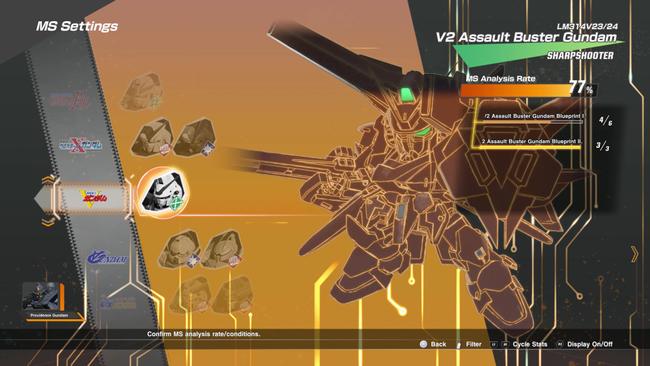
Since I feel this game is so multiplayer-centric to having a pleasant time, it’s worth mentioning that SD Gundam Battle Alliance only supports cross-play within the same family of systems. This means that PS4 and PS5 players can play with each other; Xbox Series X|S, Xbox One, and Windows PC players that bought the game from the Microsoft Store can connect together as well. The Switch and Steam versions cannot cross-play with anyone else, and the Switch release has the unique feature of local co-op with other nearby players playing on it.
Despite its flaws, SD Gundam Battle Alliance provides a fairly unique experience in just being a challenging game in general. This is one of the few games in Gundam that heavily encourages multiplayer co-op. I hope it finds a healthy community in all the platforms it is released on, because this is not a great experience if you are intending to play it only alone. There are certainly problems on a fundamental level besides its oddly tuned balance; the AI partners and camera often perform poorly, while some of its environments are straight up borderline visually unnavigable. Yet, I am left impressed with how technical the gameplay is and how carefully Artdink designed the game’s framework to emphasize teamwork and synergy above all throughout fun Gundam crossover stages. It’s not perfect, but I am thankful that this kind of game can still exist.
